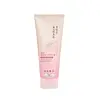What's inside
What's inside
 Key Ingredients
Key Ingredients

 Benefits
Benefits

 Concerns
Concerns

 Ingredients Side-by-side
Ingredients Side-by-side

Water
Skin ConditioningSodium Laureth Sulfate
CleansingDecyl Glucoside
CleansingCocamidopropyl Betaine
CleansingGlycerin
HumectantPEG-55 Propylene Glycol Oleate
Propylene Glycol
HumectantSodium Chloride
MaskingPanthenol
Skin ConditioningPEG-7 Glyceryl Cocoate
EmulsifyingPhenoxyethanol
PreservativeGlycol Distearate
EmollientTocopheryl Acetate
AntioxidantPolyquaternium-39
Cocamide Mea
EmulsifyingLaureth-10
EmulsifyingDisodium EDTA
Sodium Benzoate
MaskingHydroxypropyl Cyclodextrin
MaskingPantolactone
HumectantBenzoic Acid
MaskingBisabolol
MaskingIodopropynyl Butylcarbamate
PreservativeWater, Sodium Laureth Sulfate, Decyl Glucoside, Cocamidopropyl Betaine, Glycerin, PEG-55 Propylene Glycol Oleate, Propylene Glycol, Sodium Chloride, Panthenol, PEG-7 Glyceryl Cocoate, Phenoxyethanol, Glycol Distearate, Tocopheryl Acetate, Polyquaternium-39, Cocamide Mea, Laureth-10, Disodium EDTA, Sodium Benzoate, Hydroxypropyl Cyclodextrin, Pantolactone, Benzoic Acid, Bisabolol, Iodopropynyl Butylcarbamate
Water
Skin ConditioningStearic Acid
CleansingMyristic Acid
CleansingGlycerin
HumectantPotassium Hydroxide
BufferingCocamide DEA
EmulsifyingPolyquaternium-7
PEG-100 Stearate
Glyceryl Stearate
EmollientCocamidopropyl Betaine
CleansingSodium Laureth Sulfate
CleansingParfum
Masking1,2-Hexanediol
Skin ConditioningCaprylyl Glycol
EmollientButylene Glycol
HumectantOryza Sativa Seed Protein
AntioxidantLactobacillus/Rice Ferment Filtrate
Skin ConditioningSaccharomyces/Rice Extract Ferment Filtrate
Skin ConditioningSaccharomyces/Rice Ferment Filtrate
Skin ConditioningOryza Sativa Extract
AbsorbentDisodium EDTA
Sodium Chloride
MaskingSodium Hyaluronate
HumectantWater, Stearic Acid, Myristic Acid, Glycerin, Potassium Hydroxide, Cocamide DEA, Polyquaternium-7, PEG-100 Stearate, Glyceryl Stearate, Cocamidopropyl Betaine, Sodium Laureth Sulfate, Parfum, 1,2-Hexanediol, Caprylyl Glycol, Butylene Glycol, Oryza Sativa Seed Protein, Lactobacillus/Rice Ferment Filtrate, Saccharomyces/Rice Extract Ferment Filtrate, Saccharomyces/Rice Ferment Filtrate, Oryza Sativa Extract, Disodium EDTA, Sodium Chloride, Sodium Hyaluronate
 Reviews
Reviews

Ingredients Explained
These ingredients are found in both products.
Ingredients higher up in an ingredient list are typically present in a larger amount.
Cocamidopropyl Betaine is a fatty acid created by mixing similar compounds in coconut oil and dimethylaminopropylamine, a compound with two amino groups.
This ingredient is a surfactant and cleanser. It helps gather the dirt, pollutants, and other impurities in your skin to be washed away. It also helps thicken a product and make the texture more creamy.
Being created from coconut oil means Cocamidopropyl Betaine is hydrating for the skin.
While Cocamidopropyl Betaine was believed to be an allergen, a study from 2012 disproved this. It found two compounds in unpure Cocamidopropyl Betaine to be the irritants: aminoamide and 3-dimethylaminopropylamine. High-grade and pure Cocamidopropyl Betaine did not induce allergic reactions during this study.
Learn more about Cocamidopropyl BetaineDisodium EDTA plays a role in making products more stable by aiding other preservatives.
It is a chelating agent, meaning it neutralizes metal ions that may be found in a product.
Disodium EDTA is a salt of edetic acid and is found to be safe in cosmetic ingredients.
Learn more about Disodium EDTAGlycerin is already naturally found in your skin. It helps moisturize and protect your skin.
A study from 2016 found glycerin to be more effective as a humectant than AHAs and hyaluronic acid.
As a humectant, it helps the skin stay hydrated by pulling moisture to your skin. The low molecular weight of glycerin allows it to pull moisture into the deeper layers of your skin.
Hydrated skin improves your skin barrier; Your skin barrier helps protect against irritants and bacteria.
Glycerin has also been found to have antimicrobial and antiviral properties. Due to these properties, glycerin is often used in wound and burn treatments.
In cosmetics, glycerin is usually derived from plants such as soybean or palm. However, it can also be sourced from animals, such as tallow or animal fat.
This ingredient is organic, colorless, odorless, and non-toxic.
Glycerin is the name for this ingredient in American English. British English uses Glycerol/Glycerine.
Learn more about GlycerinChances are, you eat sodium chloride every day. Sodium Chloride is also known as table salt.
This ingredient has many purposes in skincare: thickener, emulsifier, and exfoliator.
You'll most likely find this ingredient in cleansers where it is used to create a gel-like texture. As an emulsifier, it also prevents ingredients from separating.
There is much debate on whether this ingredient is comedogenic. The short answer - comedogenic ratings don't tell the whole story. Learn more about comegodenic ratings here.
The concensus about this ingredient causing acne seems to be divided. Research is needed to understand if this ingredient does cause acne.
Scrubs may use salt as the primary exfoliating ingredient.
Learn more about Sodium ChlorideSodium Laureth Sulfate (SLES) is a foaming, cleansing, and emulsifying ingredient. It is created from palm kernel oil or coconut oil. SLES is not the same as sodium lauryl sulfate. It is much milder and less likely to irritate.
SLES helps create foam in personal products. It also prevents ingredients from separating, helping to elongate the shelf life.
Sodium Laureth Sulfate is a type of sulfate. It can be drying. We recommend speaking with a professional about using this ingredient if you have concerns.
Learn more about Sodium Laureth SulfateWater. It's the most common cosmetic ingredient of all. You'll usually see it at the top of ingredient lists, meaning that it makes up the largest part of the product.
So why is it so popular? Water most often acts as a solvent - this means that it helps dissolve other ingredients into the formulation.
You'll also recognize water as that liquid we all need to stay alive. If you see this, drink a glass of water. Stay hydrated!
Learn more about Water